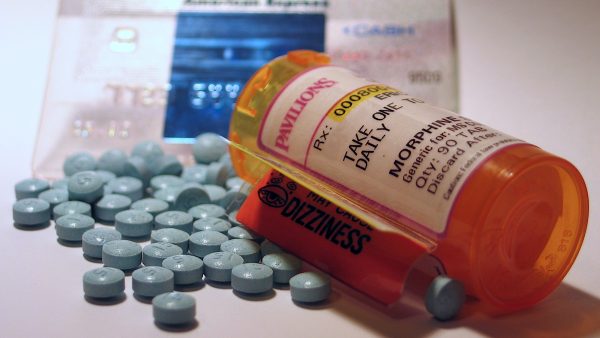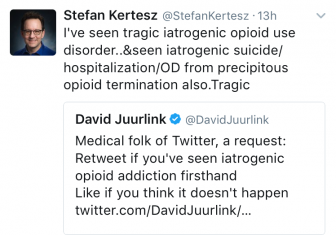To Prescribe or Not to Prescribe? Opioid Crisis Presents Ethical Dilemma
Deaths from prescription opioids like oxycodone and hydrocodone have more than quadrupled since 1999. So today, doctors trying to treat pain face a dilemma: to prescribe or not to prescribe? It’s a difficult question for health professionals who want to treat patients without sending them down the path to addiction. For example, at Birmingham’s Phoenix Clinic for homeless or formerly homeless veterans, Dr. Stefan Kertesz is examining Stacey Haley, who’s struggling with a brace and a very arthritic knee.
“So now we’re dealing with pain, right?” asks Kertesz. “And the problem is it’s not been easy to get this knee feeling well? So let’s talk about that.”
And they do talk, in detail, for almost a half an hour. The reasons the course of treatment isn’t an easy call are that Haley is working and doesn’t want to be sidelined by surgery, and there’s a potential red flag when it comes to prescribing opioids: he’s struggled with addiction in the past. But standard meds aren’t working. So Dr. Kertesz starts him on Tramadol.
“As long as they’re non-narcotics, I’m willing to try anything,” says Haley.
Kertesz replies, “I gotta break it to you, Tramadol is partly narcotic.”
But Haley is reassured because Kertesz explains that Tramadol is relatively low-potency. The main reason Kertesz is comfortable giving it to Haley, though, is that he sees Haley regularly.
“So we have to have a pretty careful conversation in the next few weeks about how it’s going,” Kertesz explains. “My expectation is we’re going to converse about whether it made you feel differently, whether you thought you were getting a buzz from it.”
It’s a dilemma doctors face every day: prescribe medicine that could relieve pain and keep patients functional, or withhold it because of potential addiction. Kertesz says taking time to really know patients is the only way to assess those risks. But in recent years, at least five states have limited the doses doctors can prescribe. And that worries him.
“Doctors are being told, ‘get the dose down, no matter what.’ And they’re saying, ‘I have no time, so I’ll just take everybody off, and who knows what happens to those people?’”
Patients who stop taking opioids often seek illegal drugs or suffer debilitating withdrawal.
“It’s usually a complicated situation,” says Kertesz. “That’s why a public policy solution that’s rooted on pill control alone will probably not work.”
At the same time, over-prescription has done tremendous harm. Several states, including Alabama, have more opiate prescriptions than people. And none of it happened overnight. David Juurlink, head of clinical pharmacology and toxicology at the University of Toronto, explains:
“One of the critical things that happened in the 1990s and early 2000s that helped doctors become more comfortable prescribing opioids for chronic pain was the assertion that addiction was rare. And we were told – I remember being taught myself – that less than one percent of people who were on opiates for chronic pain would become addicted.”
But he says it’s actually about five times that. Many trace the misconception to a widely cited one-paragraph letter in the New England Journal of Medicine in 1980, decades before its content could be easily checked online. The letter said the risk of addiction in a very specific, small patient population was low. But drugmakers, lobbyists, and some doctors overgeneralized that letter to quiet wider concerns about addiction. Juurlink just published a paper noting that, while the median number of similar letters’ citations was 11, that letter has been cited 608 times.
“There is a dark element to this, in what I’ll call the pain lobby,” Juurlink says. “There’s money at stake here. If doctors were to suddenly start using opioids less readily, and for shorter durations and at lower doses, the companies that have made tens of billions-with-a-B dollars would be unhappy.”
Juurlink is in something of a Twitter battle with Dr. Kertesz: Juurlink emphasizing the harms of over-prescription; Kertesz pointing out that government-imposed dose limits can cause harm too. But they actually agree on a lot. And Juurlink hasn’t stopped prescribing opioids altogether.
“It’s very tough,” he says. “My take is that they have a role … I tend to use them in people in whom other therapies haven’t worked or are too dangerous, but I am extremely judicious with the dosing.”
Juurlink and Kertesz also agree on this: because lives are at stake, there are no easy answers to the question of when to prescribe opioids.
NPR’s Stephen Bisaha contributed to this report.
Auburn fires coach Hugh Freeze following 12th loss in his last 15 SEC games
The 56-year-old Freeze failed to fix Auburn’s offensive issues in three years on the Plains, scoring 24 or fewer points in 17 of his 22 league games. He also ended up on the wrong end of too many close matchups, including twice this season thanks partly to questionable calls.
In a ‘disheartening’ era, the nation’s former top mining regulator speaks out
Joe Pizarchik, who led the federal Office of Surface Mining Reclamation and Enforcement from 2009 to 2017, says Alabama’s move in the wake of a fatal 2024 home explosion increases risks to residents living atop “gassy” coal mines.
‘It’s like feeling the arms of your creator just wrapped around you’: a visit to a special healing Shabbat
Members of Temple Emanu-El in Birmingham gathered recently for their traditional Friday Shabbat service. But this particular service was different, as could be seen by all the people dressed in their finest pink.
Space Command is coming to Huntsville. What might that mean for first-time homebuyers
While Huntsville has been a more affordable market than other growing cities, what’s it been like for those looking for their first home?
Colorado says relocation of Space Command to Alabama is ‘punishment’ for mail-in voting
The litigation announced by Colorado Attorney General Phil Weiser asks a federal judge to block the move as unconstitutional.
Breaking down Alabama’s CHOOSE Act
It’s been a year since Alabama legislators passed the CHOOSE Act allowing families to apply for state funds to use towards homeschool expenses and tuition for participating private schools. The Alabama Daily News’ education reporter Trisha Powell Crain has been diving into how the funds are being used. WBHM’s Andrew Gelderman sat down with her to talk about what we’re seeing so far.










